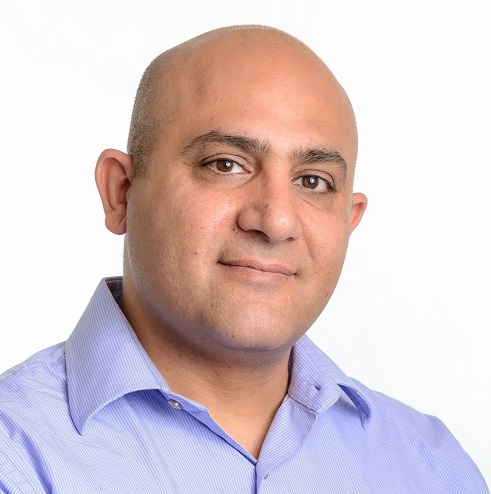As Small as It Gets

Dr. Doron Naveh constructs transistors from two dimensional and topological materials, and studies dichalcogenide spintronics, hoping to change the paradigm of nano-electronics
Dr. Doron Naveh studies transistors from two dimensional and topological materials, for studies in spintronics and optoelectronics, hoping to change the paradigm of nano-electronics
In 2010, British physicists Andre Geim and Konstantin Novoselov were awarded the Nobel Prize in Physics for their work on isolating materials into single atom thick layers. Specifically, they were awarded for their development of the two dimensional carbon allotrope, graphene - that is single atom thick. Since then, the field of two dimensional materials has become increasingly popular across the globe.
At BIU’s Faculty of Engineering, Dr. Doron Naveh and his team lead the study of 2D materials electronics. “My team is dedicated to the study of electronic and optoelectronic devices formed by a single or a few atomic layers. We use them to produce ultimately miniaturized semiconductors and construct electronic devices with distinctive characteristics,” explains Naveh. “One such material is Graphene, the best conductor known to man. It conducts electricity and heat better than any metal, transparent to light, harder than diamonds and stronger than steel.
In 2016, the Nobel Prize in Physics was awarded to a group of scientists who discovered new types of 2D materials called topological insulators. The entire family of two dimensional materials possesses unique electronic states and physical properties enabling the transport of “protected currents”, immune to scattering that can revolutionize electronic devices. 2D materials can be used for various purposes, such as faster, energetically efficient and even flexible or foldable electronic products in the future.
A technology based energetically efficient transistors can, for instance, result in phone batteries that sustain power for a week or two, rather than just a few hours at a time and that may be a significant improvement achieved by low power consumption. Another type of devices that 2D materials may enable in the future is quantum electronic devices, which are far more effective than classical electronic devices.”
One of the most fascinating aspects of 2D materials, owing to their ultimate confinement, is their interaction with light. “The two-dimension materials are much thinner than the wavelength of light, and thus are relatively transparent. However, under illumination, the absorbed light excites electrons to higher quantum energy level – leaving a hole behind and the attraction between the positive hole and negative electron is very strong in result of their physical confinement to the atomic layer. One other aspect of light-matter interactions is related to symmetry, where for example two atomic layers share an inversion symmetry between them – in contrast with a single layer, resulting in fundamentally different interactions with light, as dictated from quantum mechanics.”
Naveh (44) is a married father of “two of the sweetest kids in the world”. He completed his BSc and MSc in Materials Engineering and Physics at Ben-Gurion University of the Negev, and his PhD in Materials Science at the Weizmann Institute of Science. He completed one post doctoral fellowship at Carnegie Mellon and another at Princeton University. Five years ago he joined the BIU’s Faculty of Engineering, which he now calls his second home. “The familial environment, the atmosphere of synergy and collaboration; no wonder our researchers are so successful. We belong to a very supportive and flexible organization. Both the administration and the researchers are very helpful and there’s a true feel of comradery. You couldn’t find a better, more cultivating work or study setting.”
In his lab, which is a part of the Nano Electronics program in Electrical Engineering, Naveh uses the topological insulators and atomic layers of semiconductors to construct unique transistors that may become a platform for the development of quantum electronics and super sensitive light detectors, operating simultaneously at the visible light and infra red light. He also researches spintronics: “In some of these devices the angular momentum and the linear momentum of the electrons are coupled. That means that an electron moving to the right also has a defined spin, and an electron moving to the left has the opposite spin. This enables the construction of devices that utilize the electron spin degree of freedom in addition to its charge,” explains Naveh. “This has immense consequences on the continued development of the field of electronics.
In the past four decades, the advancement of electronics relied on cascading more transistors per area via miniaturization. The objective was to include as many transistors as possible per area unit, in order to optimize the cost of silicon area with more complex architectures, much like urban development from towns to big cities. We are now at a point where the transistors will be measured on a scale of a few dozen atoms, and further miniaturization may turn cost inefficient. In order for this field to continue and evolve, a new paradigm needs to emerge. One such paradigm is to control the electron’s electric charge as well as its spin. Controlling these twin properties may result in a far more efficient logic - that would replace zeros and ones by more complex and rich class of symbols. Eventually, instead of miniaturizing the transistors in order to fit more of them to an area unit, we’ll focus on making smarter transistors.”
Last Updated Date : 04/12/2022



